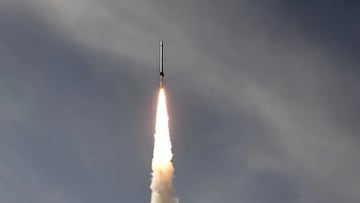Why is NASA firing rockets into the 8 April 2024 solar eclipse?
NASA is making the most of the total solar eclipse on 8 April, an event that won’t happen over the US again for 20 years, launching 3 rockets into its path.

People across North America will have the chance to see a once-in-a-generation celestial event on Monday 8 April. A solar eclipse will start over the center of the Pacific and then traverse Mexico, the US and Canada before ending over the Atlantic Ocean.
Follow solar eclipse in USA 2024 live online: reactions, best images and latest news.
For a second time in seven years, the path of totality will sweep across the United States from one side to the other. NASA doesn’t want to miss the opportunity to study the celestial event which won’t happen again over the Lower 48 until 2044.
A group of researchers from the space agency’s Wallops Flight Facility in Virginia won’t just be observing the awe-inspiring event with special glasses but with a tool they’ve become experts at using. Like with the 2017 total solar eclipse over the US, they will be launching three rockets into the path of the Moon’s shadow during the solar eclipse.
Why is NASA firing rockets into the 8 April 2024 solar eclipse?
The path of totality, the area where direct light from the sun will be completely blotted out, will cross the United States from Texas to New England. It will last more than twice as long as the 2017 event and the path of totality will be almost twice as wide.
The celestial event will give scientists an opportunity to “study how Earth’s upper atmosphere is affected when sunlight momentarily dims over a portion of the planet,” according to NASA. Specifically, they will be looking at the disturbances created in the ionosphere, which is the boundary between Earth’s lower atmosphere and the vacuum of space, when the Moon eclipses the Sun.
NASA is using three rockets that will act like 15
The US space agency will use three sounding rockets which will themselves, each “eject four secondary instruments the size of a two-liter soda bottle,” that will allow researchers to gather similar data as if they had launched 15 rockets.
The Atmospheric Perturbations around Eclipse Path (APEP) are the same rockets that had previously been used during the October 2023 annular solar eclipse. They were successfully recovered from White Sands Test Facility in New Mexico and refurbished for this latest mission led by Aroh Barjatya, a professor of engineering physics at Embry-Riddle Aeronautical University in Florida.
The rockets will be launched at three different times from NASA’s Wallops Flight Facility in Virginia. The first will take off 45 minutes before the peak local eclipse, another during it, and then a final one 45 minutes after the peak local eclipse. The intervals are important according to NASA in order to “collect data on how the Sun’s sudden disappearance affects the ionosphere, creating disturbances that have the potential to interfere with our communications.”
“Understanding the ionosphere and developing models to help us predict disturbances is crucial to making sure our increasingly communication-dependent world operates smoothly,” said Barjatya.
Several teams across the US will be using other means to take measurements of the ionosphere during the solar eclipse. Together, with the data from the sounding rockets, it will aid in providing the pieces of the puzzle needed to create a more complete picture of ionospheric dynamics.
What are sounding rockets?
Sounding rockets can be ideal for carrying out scientific experiments able to transport scientific instruments into regions of space like the ionosphere, which is between 55 to 310 miles above the ground. This region is too low for satellites and parts are too high for weather balloons.
The three APEP sounding rockets are expected to reach a maximum altitude of 260 miles. Typically, this type of rocket spends a short time in space, between 5 and 20 minutes.
For those that want to follow the APEP launches live, NASA’s Wallops’ official YouTube page will live stream them as well as NASA’s official broadcast of the total solar eclipse. You can also see them in person at the NASA Wallops Flight Facility Visitor Center from 1pm to 4pm ET on Monday 8 April 2024.






